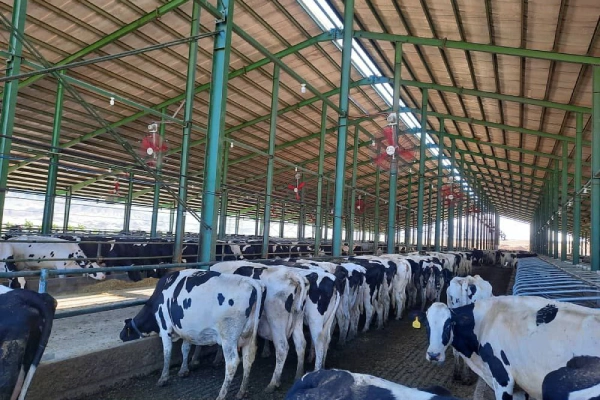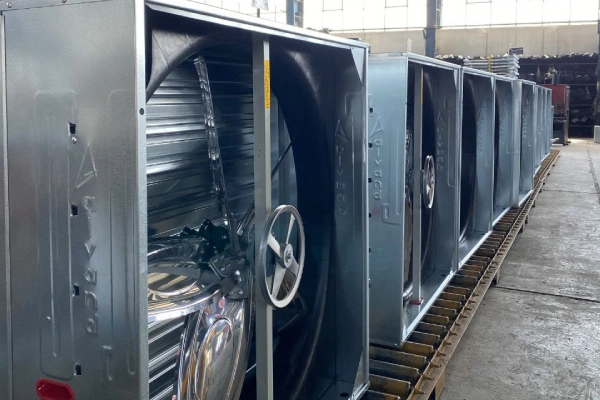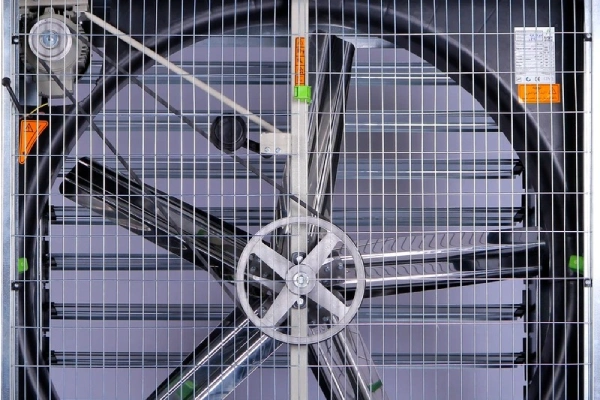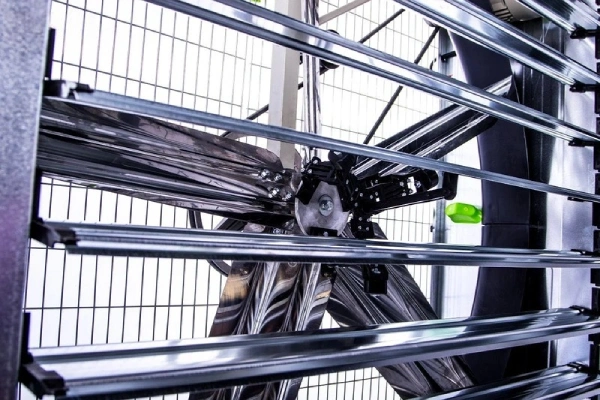Principles of Livestock Housing Hygiene + Key Points to Follow

As one of the essential industries for providing animal protein, livestock farming requires strict adherence to hygiene principles. Proper hygiene in livestock housing plays a central role in disease prevention, increasing production, and improving the quality of animal products. Adequate ventilation, as one of the most important factors in maintaining hygiene, can have a significant impact on animal health and productivity. In this article, we will discuss the principles of livestock housing hygiene.
Table of Contents
- Livestock Hygiene: The Key to Herd Health and Productivity
- Livestock Housing Hygiene: A Healthy Environment for Farmed Animals
- The Vital Role of Ventilation in Livestock Housing Hygiene
- Alvand Industrial Group: For Your Livestock’s Health
Livestock Hygiene: The Key to Herd Health and Productivity
Livestock hygiene refers to a set of actions and care measures aimed at maintaining the health and improving the hygiene status of animals. This is achieved through disease prevention and control, improving nutrition, ensuring proper environmental conditions, and implementing regular hygiene programs.
Importance of Livestock Hygiene
- Reducing Mortality: By preventing and controlling diseases, livestock mortality decreases, resulting in increased economic productivity.
- Increasing Production: Healthy and strong animals produce more (milk, meat, etc.).
- Improving Product Quality: Products from healthy livestock are of higher quality and are more likely to be welcomed by the market.
- Preventing Disease Transmission to Humans: Some animal diseases are zoonotic, meaning they can be transmitted from animals to humans. Maintaining proper livestock hygiene prevents the spread of these diseases.

Common Animal Diseases and Prevention Methods
Livestock, like humans, can suffer from various diseases. These diseases include infectious, parasitic, nutritional, and metabolic diseases. To prevent these diseases, the following methods can be used:
- Vaccination: Vaccination is one of the most important methods of preventing infectious diseases.
- Quarantine: Quarantining new animals before introducing them to the herd helps prevent the entry of diseases into the herd.
- Environmental Hygiene: Maintaining hygiene in the animal housing, reducing pollution, and controlling disease vectors are key preventive measures.
- Proper Nutrition: Balanced nutrition and meeting all the nutritional needs of the animals strengthen their immune system and increase their resistance to diseases.
Proper Nutrition and Its Impact on Animal Health
Proper nutrition plays a crucial role in animal health. Improper nutrition can lead to various diseases such as malnutrition, obesity, and deficiencies in vitamins and minerals. A balanced diet should meet all the energy, protein, vitamin, and mineral requirements of the animals.
The Role of Vaccination and Quarantine in Herd Health
Vaccination and quarantine are two important methods for maintaining herd health. Vaccination creates immunity against infectious diseases, preventing their spread within the herd. Quarantine, by isolating new animals from the main herd, reduces the opportunity for disease transmission.
Animal Housing Hygiene: A Healthy Environment for Farmed Animals
Animal housing hygiene is one of the fundamental pillars in the livestock industry, directly affecting the health, welfare, and economic performance of the herd. A hygienic housing environment provides a safe and clean space for the animals and helps prevent the onset of many diseases.
1. Proper Design and Construction of the Housing
-
Choosing the Right Location: The location of the housing should be away from pollution sources such as sewage, trash dumps, and marshy areas. Additionally, easy access to clean water and transportation facilities are key factors in selecting a suitable location.
-
Construction Materials: The materials used in building the housing should be durable, hygienic, and easy to clean. It is recommended to use materials such as concrete, brick, and ceramic for the floor and walls.
-
Size and Stock Density: The size of the housing should be proportional to the number of animals, and the stocking density should allow each animal sufficient space to move and rest. High stocking density can lead to increased stress, the spread of diseases, and reduced production.
-
Adequate Lighting: Providing sufficient and appropriate lighting in the housing positively affects the health and productivity of the animals. Natural light is the best option, but if natural light is not available, suitable artificial lighting systems should be used.

2. Essential Equipment and Facilities
-
Hygienic Water Supply System: Providing clean and safe water for the animals is of utmost importance. The water supply system should be designed in such a way that it delivers clean water free of any contaminants to the animals.
-
Waste Collection and Disposal System: Proper collection and hygienic disposal of animal waste are critical for maintaining cleanliness in the housing. Waste collection and disposal systems should be regularly cleaned and disinfected.
-
Proper Ventilation System: A proper ventilation system, such as having poultry inlets, ensures fresh, pollution-free air and prevents the accumulation of harmful gases, dust, and excessive humidity in the housing. Products from Alvand Industrial Group, offering a wide range of ventilation equipment, including industrial fans and heaters, can help improve air quality in the housing.
3. Cleaning and Disinfection
-
Proper Cleaning Methods: Regular cleaning of the housing using water and suitable detergents prevents the accumulation of contaminants.
-
Disinfectants: The use of appropriate disinfectants to eliminate pathogenic microorganisms is essential.
-
Cleaning and Disinfection Frequency: The frequency of cleaning and disinfection depends on the type of animals, the herd size, and environmental conditions.
You might be wondering why we need to know about industrial ventilation standards. For a cost-effective purchase and to avoid potential losses to your animals, you can click on the relevant link.
4. Pest and Parasite Control
-
Pest and Parasite Control Methods: The use of insecticides, anti-parasitic chemicals, and biological control methods are some of the ways to manage pests and parasites.
-
Importance of Spraying: Regular spraying of the housing with suitable pesticides while adhering to safety guidelines prevents pest and parasite outbreaks.
5. Proper Waste Management
-
Proper Waste Disposal Methods: Proper disposal of livestock waste, including manure, carcasses, and other by-products, helps prevent environmental pollution and the spread of diseases.
-
Preventing Environmental Pollution: Waste disposal should be carried out in a manner that prevents contamination of groundwater, soil, and air.
Animal housing hygiene is an ongoing and continuous process that requires constant attention and care. By adhering to the hygiene principles and using suitable equipment, a healthy and safe environment can be provided for the animals, ultimately enhancing productivity and profitability in livestock farming. Products from Alvand Industrial Group, with their innovative solutions in ventilation and environmental control, can significantly contribute to improving the hygiene conditions of animal housing.
The Vital Role of Ventilation in Livestock Housing Hygiene
A suitable industrial ventilation fan is one of the key components in maintaining hygiene in livestock housing. Parameters such as temperature, humidity, air speed, and dust levels directly affect the health and productivity of the animals. Improper ventilation can lead to an increased spread of diseases, reduced production, and heat or cold stress in animals.
Benefits of Using Alvand Industrial Group’s Ventilation Equipment
-
Improved Air Quality: The use of livestock fans helps remove pollutants and provides fresh air, creating a healthier environment for the animals.
-
Reduction of Heat and Cold Stress: Maintaining an appropriate temperature in the barns prevents heat and cold-related diseases.
-
Increased Production: A well-ventilated environment leads to higher milk and meat production in livestock.
-
Reduced Disease Spread: By reducing pollutants and creating proper airflow, ventilation helps prevent the spread of respiratory and infectious diseases.
Applications of Alvand Industrial Group’s Products in Livestock Farming
-
Ventilation Systems for Dairy Barns: Ensuring fresh and cool air in dairy barns creates ideal conditions for milk production.
-
Industrial Heaters for Barn Heating: Maintaining the proper temperature during cold seasons is essential, especially for young and pregnant animals.
-
Industrial Fans for Ventilation and Humidity Reduction: Creating airflow and reducing humidity prevents the growth of bacteria and fungi.
By using the appropriate ventilation equipment from Alvand Industrial Group, a healthy and ideal environment can be created for livestock, leading to increased economic productivity in farming.

Conclusion
Livestock housing hygiene is key to animal health and productivity in the livestock industry. Adhering to hygiene principles, from proper barn design to effective ventilation, plays a crucial role in disease prevention and improving the quality of animal products. The use of advanced ventilation equipment is an important step in creating a healthy and ideal environment for livestock. Investing in barn hygiene can lead to healthier products and increased profitability in the livestock industry.
Alvand Industrial Group: For the Health of Your Livestock
With years of experience, Alvand Industrial Group is a leader in producing various heating, cooling, and industrial ventilation equipment. High-quality Alvand products, including jet heaters and fans, create a healthy and efficient environment for livestock farms and various industries. Looking to improve the environmental conditions of your farm? Alvand’s diverse products are the perfect solution for your needs. Contact the experts at Alvand today to find the best solutions for your business.




 2025-01-20
2025-01-20 31 minute
31 minute
 0 comment
0 comment